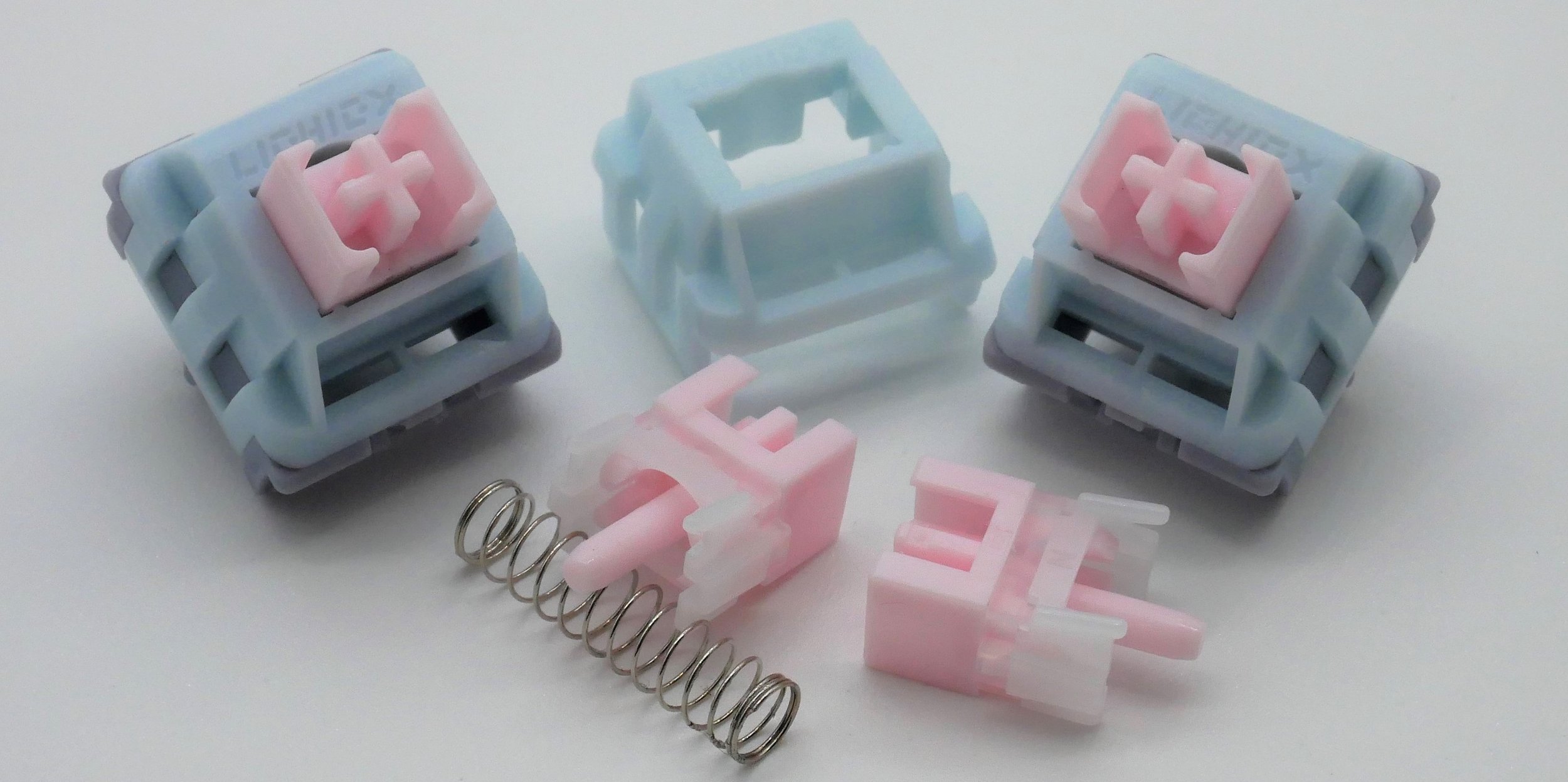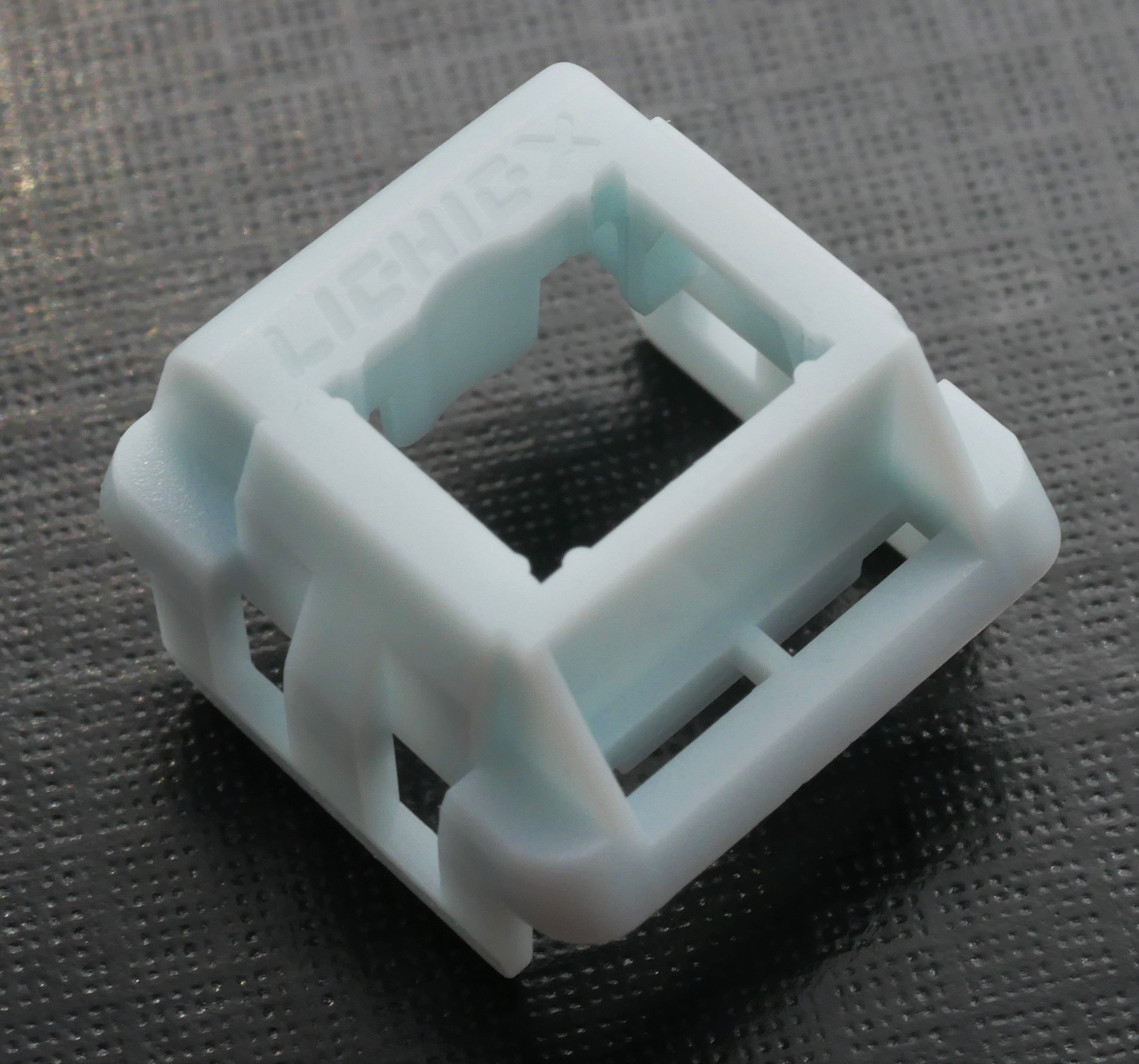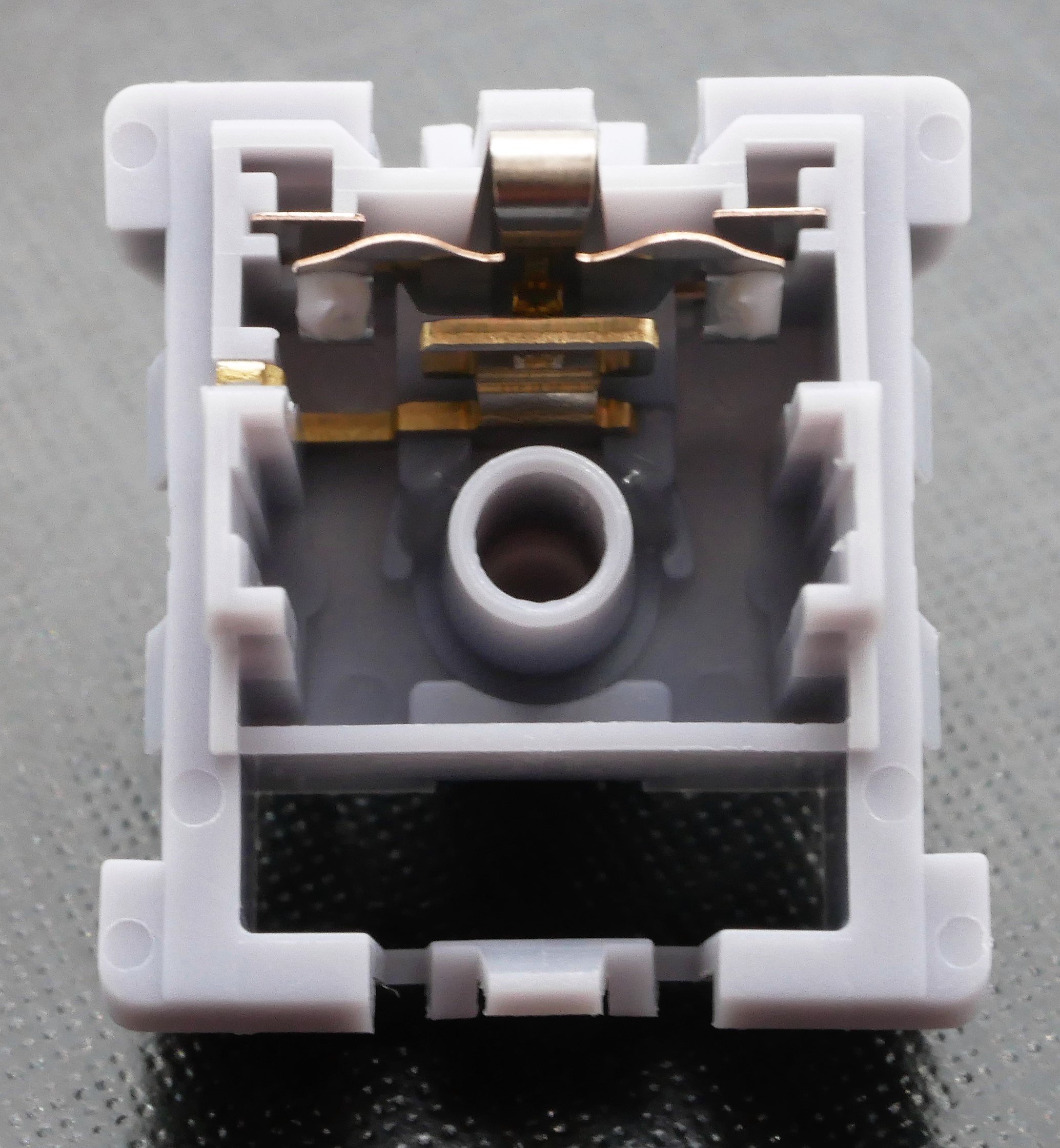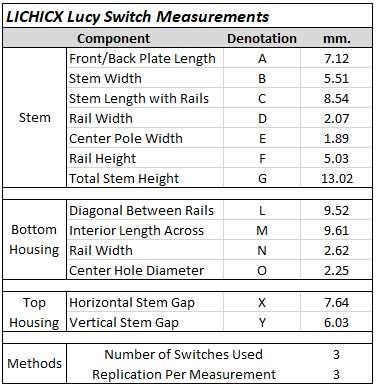LICHICX x XCJZ Lucy switch reviewed by ThereminGoat
What is LICHICX x XCJZ Lucy switch performance? Hope you will make your consideration after reading ThereminGoat's review. If you'd like to now more detail comparison, please no heistate to read ThereminGoat's full review here.
At the highest level, the LICHICX Lucy switches come in a three-part colorway with pastel pink dustproof stem, blue winglatch top housing, and purple 5-pin bottom housing. Not knowing if ‘Lucy’ is supposed to be referring to some form of anime character or not, I am under the assumption that this is somehow a weeb-related colorway decision (unfortunately). The switches have several LICHICX-specific features which help distinguish them from other switch brands currently, but the two most readily noticeable features include the ‘LICHICX’ nameplate as well as the ever so slightly rounded interior corners of the dustproof stems. Beyond this initial exterior design, the Lucys also come preinstalled with a normal length, approximately 55g bottom out silver spring and a set of entirely silver colored leaves, the latter of which is a slight departure from other known LICHICX branded switches. Further details regarding specific mold markings and design features of the note in each component will be discussed below.

Figure 7: LICHICX Lucy switch and its components.
Looking first at the top housings of the Lucy switches, these are fairly similar at first glance to brands like Kailh and KTT which also predominantly tout winglatch style top housings. Externally, there’s very little that necessarily separates LICHICX from these brands, save for their namesake nameplate as well as use of POK as a top housing material. I would also like to note the LED slot of the Lucys appears significantly more rigid in its rectangular shape, with a thin bifurcation through the center that feels distinctive from the other aforementioned brands. Admittedly, though, this may just be my mind playing tricks on itself and seeing differences which just aren’t there. Internally, the architecture of the Lucy top housings is much more different from Kailh and KTT, with everything from the rail-supporting regions on the N/S side to the mold ejector marks along the upper rim appearing noticeably different. While I will let the photos below stand to demonstrate each of these points, the most immediate mold marking that may not readily show in the photos is the single capital letter mold marking in the upper right-hand corner underneath the nameplate region. While this is a traditionally common place to find a mold marking in a top housing, the entire corner being cut out for this stamp rather than just a thin rectangle directly adjacent to the nameplate gap is a bit less orthodox.

Figure 8: LICHICX Lucy top housing external design showing 'LICHICX' branded nameplate, winglatch style connector, and bifurcated LED slot.

Figure 9: LICHICX Lucy top housing internal design showing broadly unique architecture and singular capital letter mold marking in upper right-hand corner.
Moving next to the stems of the LICHICX Lucy switches, these are by far the most innovative and unique features found in LICHICX branded switches. While these immediately strike a resemblance to clickjacket switches such as Cherry MX Blues, the two differently colored components are actually fixed to each other and don’t articulate independently like they would in a clicky switch. The top, pink portion and the bottom, milky white portion appear to be made of POM like traditional stem designs, whereas the thin, clear plastic inner layer is a silicone silencing layer that spans across the entirety of the underside of the stem. As described in my short article surrounding this mechanism, the silencing at bottom out occurs when the upper rim of the center pole hole in the bottom housing collides with the interior of this silicone layer around the center stem pole. Bottoming out does not occur on the slider rails or center pole with these stems. It’s also worth noting that while it is hard to see in the photos below, there is a very thin, subtle application of lube which is present on nearly all parts of the stem which reside in the closed switch housing. In an incredibly unique fashion, the mold markings on the stems are relegated to the front of the LUCY stems and come in the form of two capital letter markings – one on the upper, pink side of the stem and one on the milky colored bottom potion. Beyond this unique mold marking location and the three-piece construction of the stem itself, they are fairly standard by traditionally inspected features, having no tapering on the slider rails nor tiers to the center pole.

Figure 10: Front and backside of LICHICX Lucy stems showing front plate mold markings, middle silencing layer, and lack of tapered stem rails or center pole.

Figure 11: Close up zoom of LICHICX Lucy stem mold markings including upper, sideways one on pink portion of stem and bottom centered marking on milky white portion.
Striking a midground between the top housings and the stems, the pastel blue, nylon mixture bottom housings carry some features which separate them from other brands of switches though they are not necessarily revolutionarily different on their own. Internally, the most unique feature comes in the form of a slightly more aggressive and oddly shaped north-side spring collar. While there is a normally shaped south side spring collar, the north side appears to wrap partially around the center pole hole mast to perhaps more readily hold the spring in place. Also, the slider rails appear to have a pair of thin ridges within their span that assumedly are in place to prevent direct and complete contact between the slider rails and the stems in order to reduce potential friction. Beyond these points internally, the use of an entirely silver colored pair of leaves is also quite uncommon, having only been seen in a small subset of switches I’ve looked at over the years. Externally, the bottom housings are also fairly stand out with three specific features worth noting: the thinness of the plastic PCB-support pins, the ever so tiny slit in the upper center edge of the housing, and the incredibly small capital letter followed by number mold marking which is upside down and located just underneath the slit. All of these features were utilized in connecting the LICHICX brand to the Varmilo EC switches, as they too share these distinctive features not seen in other switch brands.

Figure 12: LICHICX Lucy bottom housing interior design showing mold ejector circles on upper rim and aggressive north side spring collar.

Figure 13: LICHICX Lucy bottom housing design showing LICHICX-specific features of the upside down, centered mold marking location and small slit on upper edge of the housing.
Push Feel
To summarize the experience of typing on the LICHICX Lucy switches as best I can, I would have to say that they are certainly strange. Strange, not necessarily because they have anything unpredictable nor unique to their linearity at all, but rather because they very much do not fit the mold and expectations common of conventional silent linear switches. First and foremost, these switches are extremely smooth throughout their stroke even though they have only the thinnest application of lube across the four sides of the stem. Upon first trying these in hand, I would have assumed a much more heavy lube application by the factory, as they carry a sort of weighted feeling to the downstroke that is very much in line with a hand-lubed switch and definitely not common in switches lubed this thinly. As for the bottoming out, the Lucys have a feeling that is not mushy, gummy, or rubbery in any fashion, and instead they feel as if they are bottoming out onto a normal, thick nylon housing rather than any form of silencing mechanism whatsoever. In fact, this lack of progressive increase in force as a result of depression of a rubbery layer is completely absent in the force curve for the LICHICX Lucy switches, something which normally shows up in a curved, parabolic like increase in force as a result of traditional silent linear dampening mechanisms. To further increase the strangeness as well, the topping out is also fairly well balanced with this thick, muted bottoming out even with the housings being comprised of entirely different material.

While the LICHICX Lucy switches are largely incredibly strong performing in the push feeling section, it wouldn’t be a switch review of mine if I didn’t find some small point to criticize in any given switch. The largest issue present in the push feeling of the Lucys, which is rather small all things considered, is a subtle difference in topping out across the batch that I received. Even though it is certainly not drastic enough to warrant specifically cherry-picking certain switches out of a larger batch for a build, the slightly thinner feeling topping out in some switches is something I noticed in stock testing and that also appears to slightly increase during break in as well. Beyond this, though, there really is not all that much that I can pick apart with the Lucy switches and its rather impressive given just how fairly new to this type of switch production LICHICX has been. Even if you consider their production of Varmilo EC switches as part of an ‘extensive production history’, not even those featured anything remotely as strong performing in push feeling as the Lucys.
Sound
With the ever-important emphasis to be put on sound in the LICHICX Lucy switches given their “silent linear” description, I’m very impressed to say that they are almost without sound altogether at normal typing speeds. While at faster typing speeds you may be able to pick up some slightly louder topping out housing collisions, and especially so with respect to that subtle cross-batch variation I noted above in the push feeling section, it would be really hard to pick apart these differences unless you were explicitly looking for them. Some combination of the thin factory lube application on the slider rails, lube on the stem leg/leaf interface, and the extra thin ridges within the slider rails of the bottom housings all act to really reduce friction noises present in the sound, and in their stock form the Lucys really do not suffer at all from subtle scratchiness underpinning their otherwise quiet stroke. Bottoming outs in the Lucys, while muted like in switches with thick nylon, do carry a subtle bit of gumminess to them that acts more to highlight an already largely quiet switch sound and do not stand out upon testing much, if at all.
Wobble
For as strong of performing metrics as the LICHICX Lucy switches put up with respect to their push feeling and sound, the wobble is unfortunately a bit average among most modern mechanical keyboard switches. While certainly not likely to bother anybody looking to use these in their build, there is enough of a N/S and E/W direction stem wobble to indicate that there is room for improving the mold tolerances at LICHICX. As for the top housings, there is absolutely no wobble in them throughout the batch of switches as is common amongst winglatch style top housings.
Measurements
If you’re into this level of detail about your switches, you should know that I have a switch measurement sheet that logs all of this data, as well as many other cool features which can be found under the ‘Archive’ tab at the top of this page or by clicking on the card above. Known as the ‘Measurement Sheet’, this sheet typically gets updated weekly and aims to take physical measurements of various switch components to compare mold designs on a brand-by-brand basis as well as provide a rough frankenswitching estimation sheet for combining various stems and top housings.

Figure 16: Numerical details regarding the stock LICHICX Lucy switch force curve diagram.
The latest in the content-adjacent work that I’ve picked up, the new ‘Force Curve Repository’ is now hosted on GitHub alongside the Scorecard Repository and contains all force curves that I make both within and outside of reviews. In addition to having these graphs above, I have various other versions of the graphs, raw data, and my processed data all available for each switch to use as you please. Check it out via the ‘Archive’ tab at the top of this page or by clicking any of the force curve cards above.
Final Conclusions
The LICHICX Lucy switches are, without a doubt, an absolute masterclass when it comes to silent linear switches. An innovative design, incredible factory lubing, well executed choice of housing materials, and a general construction that is largely consistent across a large batch of switches is something that very few switches seem to pack into one housing nowadays. While there definitely is some room for improvement, and most notably so here with respect to the top housing tolerances and stem wobble, it really is hard to want for much more when testing these Lucys out both on their own and in comparison to other silent linears. I not only hope that LICHICX continues to produce these switches for some time into the future, but that they also continue to improve upon this design and the performance metrics of these switches as well. While $0.60 per switch isn’t exactly the pinnacle of performance per price budget options, it’s still more than acceptable given that these switches are usable directly out of the box, have very few if any defects, and seem to break in marginally better than most other switches I’ve reviewed on this site. I can say for a fact that I will be buying these for a build of my own in the near future and I would highly encourage anybody reading this to do the same, especially if you don’t think that you’re much a fan of silent linear switches because of bad previous experiences. The LICHICX Lucys will definitely change your mind.



